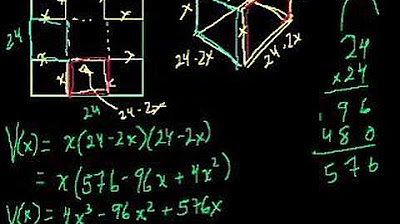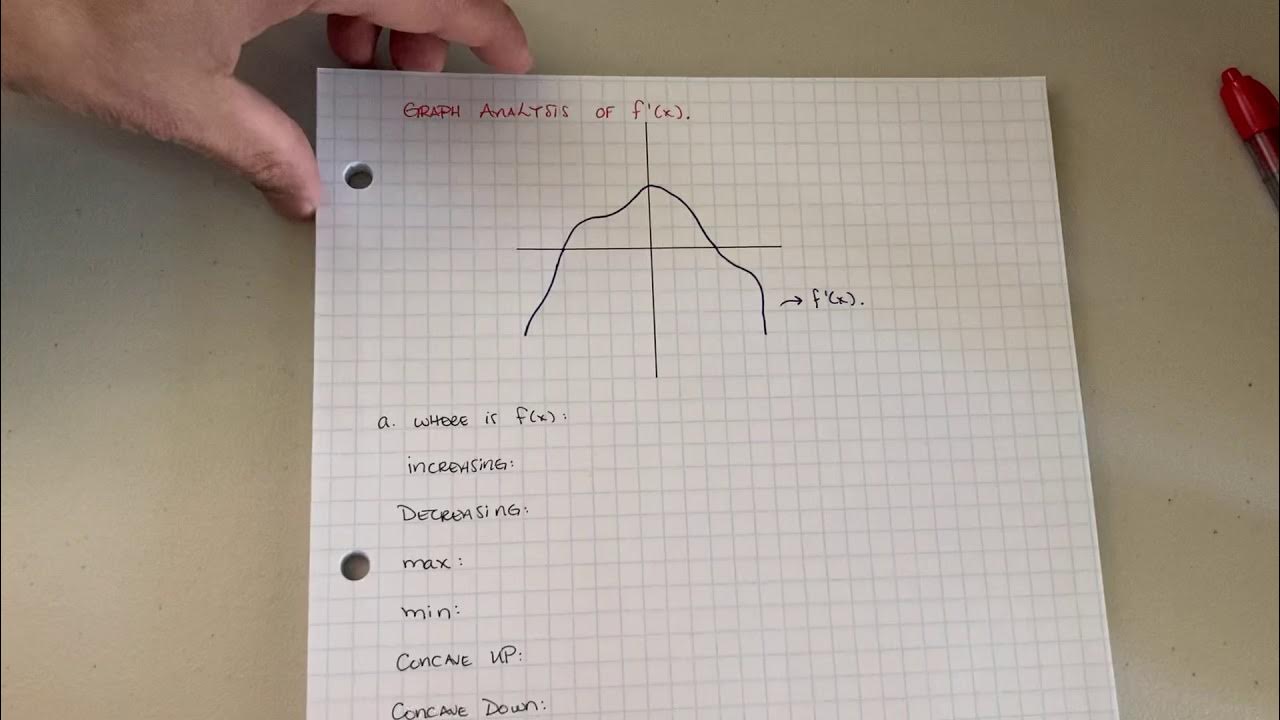Optimization with Calculus 1
TLDRThe video script presents a mathematical optimization problem involving finding two numbers with a product of negative 16 that also have the minimum possible sum of squares. Through algebraic manipulation and calculus, it is determined that the two numbers are 4 and -4. The solution is verified by analyzing the first and second derivatives of the derived function, confirming a minimum at x=4. The video also briefly touches on the concept of optimization and its applications.
Takeaways
- 🔍 The script introduces optimization problems, which involve finding maximum or minimum values under certain constraints.
- 📝 The specific problem presented is to find two numbers with a product of -16 and a minimum sum of their squares.
- 💡 To solve the problem, the script suggests expressing the optimization problem as a function of one variable to simplify the process.
- 📱 The relationship between the two numbers is given by their product, which is -16, leading to the equation y = -16/x.
- 📈 The sum of the squares of the two numbers is expressed as a function of x, which is s = x^2 + (-16/x)^2.
- 🌟 The method to find the minimum value involves taking the derivative of the function with respect to x and setting it to zero to find critical points.
- 📊 The first derivative of the sum of squares function is found to be s' = 2x - 512/x^3.
- 🎓 Setting the first derivative to zero leads to the solution x = ±4, and consequently, y = -x (since y = -16/x).
- 🔧 To confirm that the critical point is a minimum, the second derivative test is used, resulting in s'' = 2 - 1536/x^4, which is positive when x = 4.
- 🏆 The numbers 4 and -4 are identified as the pair that minimize the sum of their squares, with the sum being 32.
- 🚀 The script concludes by encouraging further exploration of other pairs with the same product to verify that the found solution is indeed the minimum.
Q & A
What is an optimization problem?
-An optimization problem is a type of mathematical problem where the goal is to find the maximum or minimum value of a function under certain constraints.
What is the first optimization problem presented in the transcript?
-The first optimization problem is to find two numbers whose product is a negative 16 and whose sum of squares is a minimum.
How are the two numbers represented in the problem?
-The two numbers are represented as x and y.
What is the relationship between x and y given by the product constraint?
-The relationship between x and y is given by the equation xy = -16.
What is the expression for the sum of squares of x and y?
-The sum of squares is expressed as s = x^2 + y^2.
How is the sum of squares rewritten as a function of one variable?
-The sum of squares is rewritten as a function of one variable by substituting y with -16/x.
What is the first step in solving the optimization problem?
-The first step is to take the derivative of the function with respect to x and set it equal to zero to find potential minimum or maximum points.
What is the first derivative of the sum of squares function?
-The first derivative of the sum of squares function with respect to x is s' = 2x - 512/x^3.
How is the critical point found?
-The critical point is found by solving the equation s' = 0, which gives x = ±4.
How is it determined if the critical point is a minimum?
-It is determined by taking the second derivative of the function and checking if it is positive at the critical point, indicating the function is concave upwards and thus at a minimum.
What is the sum of squares for x = 4 and y = -4?
-The sum of squares for x = 4 and y = -4 is 32 (4^2 + (-4)^2 = 16 + 16 = 32).
What can be concluded from the second derivative being positive at x = 4?
-A positive second derivative at x = 4 indicates that the function is concave upwards at this point, confirming that it is a minimum point.
Outlines
📚 Introduction to Optimization Problems
The paragraph introduces the concept of optimization problems, specifically focusing on finding minimum and maximum values under certain constraints. The speaker presents a problem involving finding two numbers with a product of -16 and minimizing the sum of their squares. The explanation begins with defining the variables x and y, and expressing the product as -16. The goal is to optimize the function representing the sum of squares, s, which is initially a function of two variables. The speaker then discusses the strategy of reducing the problem to a single variable function for easier optimization, using the constraint equation to express y in terms of x. The process of finding the minimum by setting the derivative of the function to zero is outlined, with the intention to confirm the minimum through further analysis.
🔢 Solving the Optimization Problem
This paragraph details the process of solving the optimization problem. The speaker continues from the previous paragraph, explaining how to find the minimum value of the sum of squares function. The derivative of the function with respect to x is calculated, and the condition for a minimum or maximum is discussed, which occurs when the derivative is zero. By setting the derivative equal to zero, an equation is formed which, when solved, gives the value of x. The speaker then finds the corresponding y value and verifies that the pair (x, y) indeed provides the minimum sum of squares. The process of confirming the minimum point by examining the second derivative of the function is also described. The speaker concludes by demonstrating that other pairs of numbers with a product of -16 result in a higher sum of squares, thus confirming that the pair (4, -4) or (-4, 4) yields the minimum sum of squares.
Mindmap
Keywords
💡Optimization problems
💡Constraints
💡Product
💡Sum of squares
💡Derivative
💡Minimum value
💡Substitution
💡Second derivative
💡Concavity
💡Critical points
💡Function
Highlights
The introduction of optimization problems and their importance in real-world scenarios.
Defining the specific optimization problem of finding two numbers with a product of negative 16 and minimizing the sum of their squares.
The use of algebraic manipulation to express the sum of squares as a function of a single variable.
Substituting the equation to express y in terms of x, simplifying the problem to a single-variable function.
The application of calculus to find the minimum value by setting the first derivative equal to zero.
Deriving the first derivative of the function and simplifying it to find the critical points.
Solving the equation for x to find the potential minimum point.
Verifying the minimum point by analyzing the second derivative and its concavity.
Calculating the second derivative and confirming its positivity, indicating a minimum point.
The conclusion that the numbers 4 and -4 yield the minimum sum of squares for the given product.
Comparing the sum of squares for different pairs of numbers with the product of -16 to validate the solution.
The practical application of the optimization problem in solving for the minimum sum of squares.
The demonstration of the problem-solving process, from understanding the problem to applying mathematical techniques and verifying the solution.
The educational value of the transcript in teaching optimization techniques and their mathematical underpinnings.
The potential for this problem to be used as a foundational example in multivariable calculus and optimization courses.
The transcript's contribution to the understanding of how to approach and solve complex mathematical problems with real-world applications.
Transcripts
5.0 / 5 (0 votes)
Thanks for rating:





